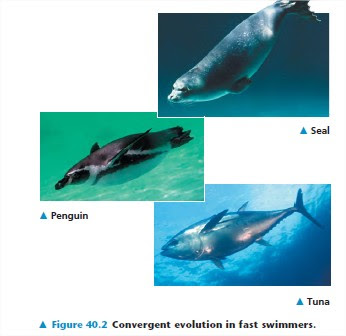Many different body plans have arisen during
the course of evolution, but these variations fall within certain
bounds. Physical laws that govern strength, diffusion, movement,
and heat exchange limit the range of animal forms.
As an example of how physical laws constrain evolution,
let’s consider how some properties of water limit the possible
shapes for animals that are fast swimmers. Water is about a
thousand times denser than air and also far more viscous.
Therefore, any bump on an animal’s body surface that causes
drag impedes a swimmer more than it would a runner or flyer.
Tuna and other fast ray-finned fishes can swim at speeds up
to 80 km/hr (50 miles/hour). Sharks, penguins, dolphins, and
seals are also fast swimmers. As is apparent in the examples in
Figure 40.2, such animals share a streamlined body contour:
a shape that is fusiform, meaning tapered on both ends. The
similar shape found in these speedy vertebrates is an example
of convergent evolution (see Chapter 22). Natural selection
often results in similar adaptations when diverse organisms
face the same environmental challenge, such as overcoming
drag during swimming.
Physical laws also influence animal body plans with regard
to maximum size. As body dimensions increase, thicker skeletons
are required to maintain adequate support. This limitation
affects internal skeletons, such as those of vertebrates, as well as
external skeletons, such as those of insects and other arthropods.
In addition, as bodies increase in size, the muscles required
for locomotion must represent an ever-larger fraction
of the total body mass. At some point, mobility
becomes limited. By considering the fraction of
body mass in leg muscles and the effective force such muscles
generate, scientists can estimate maximum running speed for a
wide range of body plans. Such calculations indicate that the dinosaur
Tyrannosaurus rex, which stood more than 6 m tall,
probably could reach speeds of 30 km/hr (19 miles/hour), about
as fast as the fastest humans can run.
Exchange with the Environment
Animals must exchange materials with their environment,
and this requirement imposes limitations on their body plans
(as it does for all multicellular organisms). Exchange occurs as
substances dissolved in an aqueous solution move across the
plasma membrane of each cell. The rates of exchange for nutrients,
waste products, and gases are proportional to membrane
surface area, whereas the amount of material that must
be exchanged to sustain life is proportional to cell volume.
The opportunity for exchange depends on the number of
cells in an organism’s body. A single-celled organism, such as
the amoeba in Figure 40.3a, has a sufficient membrane surface
area in contact with its environment to carry out all necessary
exchange. In contrast, an animal is composed of many
cells, each with its own plasma membrane across which exchange
must occur. A multicellular organization therefore
works only if every cell has access to a suitable aqueous environment,
either inside or outside the animal’s body.
Trending Post
3/footer/recent
Daftar isi penting
Cari Blog Ini
Most Recent
A Comparison of Mitosis and Meiosis
Mei 15, 2013DNA Cloning and Its Applications: A Preview
Mei 15, 2013Membuat wifi ad-hoc hosted network windows 8
Mei 08, 2013All Right Reserved Copyright ©



